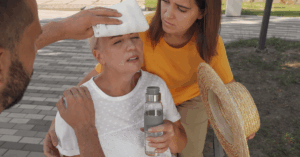Sexually transmitted diseases (STDs) are common but often misunderstood — especially when it comes to early signs. One of the most frequent questions we hear at AllCare Georgia is: What is usually the first sign of an STD? In this guide, we’ll walk through the most common early symptoms, what to do if you don’t have symptoms, and when it’s time to get tested.
What Are Sexually Transmitted Diseases?
Sexually transmitted diseases (STDs)—also known as sexually transmitted infections (STIs)—are infections that are primarily spread through sexual contact. This includes vaginal, anal, and oral sex, as well as intimate skin-to-skin contact in some cases. STDs can affect anyone, regardless of age, gender, or sexual orientation, and can be caused by bacteria, viruses, or parasites. Most STDs are treatable, and many are curable with the proper care.
Types of STDs
- Bacterial STDs: Caused by bacteria, bacterial STDs are typically curable with antibiotics. The most common bacterial infections include chlamydia, gonorrhea, and syphilis.
- Viral STDs: Caused by viruses. While they may not be curable, many viral STDs can be effectively managed with medication. These include HIV (Human Immunodeficiency Virus), herpes (HSV-1 and HSV-2), HPV (Human Papillomavirus), and hepatitis B and C.
- Parasitic STDs: Caused by parasites, parasitic STDs are generally treatable with prescription medication. These include trichomoniasis, pubic lice (commonly known as crabs), and scabies, which can be spread through close physical contact, including sexual activity.
What Are the First Signs of an STD?
The early signs of an STD vary depending on the infection and the person. Some individuals notice symptoms within a few days of exposure, while others may go weeks, months, or even years without any signs. However, when symptoms do appear, some of the most common early indicators include:
1. Pain or Burning During Urination
This is a common early sign of chlamydia or gonorrhea and is often mistaken for a urinary tract infection (UTI). It may also be accompanied by more frequent urination or cloudy urine.
2. Unusual Genital Discharge
A change in the color, amount, or smell of vaginal or penile discharge can indicate an infection. Discharge caused by STDs may be yellow, green, or gray and may have a strong odor.
3. Genital Itching or Irritation
Persistent itching, redness, or swelling around the genital area may be an early sign of herpes, trichomoniasis, or other infections.
4. Sores, Blisters, or Bumps
Painless sores (common with syphilis) or painful blisters (associated with herpes) may appear in or around the genitals, anus, or mouth. These are often mistaken for ingrown hairs or other skin issues.
5. Pain During Sex
Discomfort or pain during intercourse can be an early sign of certain infections, including chlamydia or trichomoniasis, particularly in women.
6. Vaginal Bleeding Between Periods
Spotting or bleeding after intercourse may occur with cervical infections caused by STDs.
7. Sore Throat or Swollen Lymph Nodes
Some STDs, such as oral gonorrhea or syphilis, can cause sore throats, especially after oral sex. Swollen glands in the neck or groin may also occur.
STD Symptoms in Women vs. Men
Sexually transmitted diseases (STDs) can affect people differently based on biological sex, and in many cases, symptoms are more subtle—or completely absent—in women. Understanding signs of std in women versus men is vital for early detection and treatment.
STD Symptoms in Women
The early symptoms of STDs in females can be easy to miss or mistaken for other common conditions, like yeast infections or urinary tract infections (UTIs). Some of the most common signs of STDs in women include:
- Unusual vaginal discharge (may be yellow, green, or have a strong odor)
- Burning or pain during urination
- Pelvic or lower abdominal pain
- Pain during sex
- Bleeding between periods
- Sores, bumps, or itching around the vagina or anus
STD Symptoms in Men
STD symptoms in men can appear sooner than in women and are often more noticeable. Male STD warning signs may include:
- Penile discharge (thick, cloudy, or discolored)
- Burning during urination
- Pain or swelling in the testicles
- Sores or blisters on or around the genitals or mouth
- Itching or irritation at the tip of the penis
What STDs Have No Symptoms?
Many common STDs can remain in the body without causing any noticeable symptoms. Even without signs, these infections can lead to serious health complications such as infertility, pelvic inflammatory disease, liver damage, and a higher risk of HIV transmission. Here are some of the most common STDs that may not show any symptoms:
- Chlamydia
- Gonorrhea
- Human Papillomavirus (HPV)
- HIV (especially in early stages)
- Herpes (HSV-1 and HSV-2)
- Trichomoniasis
- Hepatitis B
- Hepatitis C
- Syphilis (especially in early stages)
When Should You Get Tested for STDs?
Knowing when to get tested is just as essential as recognizing symptoms. You should consider getting tested if:
- You’ve had unprotected sex
- You’re starting a new relationship
- You or your partner have multiple partners
- A past partner has tested positive for an STD
- It has been a year or more since your last screening
- You’re pregnant or planning to become pregnant
- You want peace of mind
Testing is also recommended after any potential exposure, even if you do not notice any symptoms.
How Long Does It Take for STD Symptoms to Show?
If you’ve recently had unprotected sex or suspected exposure to an STD, it’s crucial to know when to get tested. Depending on the infection and its incubation period – the time between exposure and when infection can be reliably detected by a test – testing too early may lead to false negatives. Use the table below as a general guideline for understanding STD incubation periods and testing timeline:
| STD | Incubation Period | When to Get Tested |
| Chlamydia | 1 to 3 weeks | Test after 2 weeks; retest if negative but exposed |
| Gonorrhea | 2 to 7 days | Test after 1 week |
| Syphilis | 3 weeks to 3 months | Test at 3 weeks; retest at 3 months if needed |
| HIV | 2 to 4 weeks (some tests later) | Test at 4 weeks; retest at 3 months for certainty |
| Herpes (HSV-1/2) | 4 days to 2 weeks | Blood test: wait 4–6 weeks post-exposure |
| Trichomoniasis | 5 to 28 days | Test after 1 to 2 weeks |
| Hepatitis B | 6 weeks to 6 months | Initial test at 6 weeks; retest at 3–6 months |
| Hepatitis C | 2 to 12 weeks | Test after 6–8 weeks; follow-up if needed |
| HPV | Weeks to months | Detected during routine cervical screening (Pap) |
Note: These timelines are general recommendations. If you’ve had a recent exposure, speak with a healthcare provider to determine the right time to test based on your situation.
Walk-In STD Testing in Georgia
Early symptoms of STDs—such as itching, irritation, unusual discharge, or discomfort during urination—can be mild and easy to overlook. In some cases, they may not appear at all. That’s why timely testing is so important. At AllCare Georgia, we offer fast, confidential STD screening and treatment to help you address symptoms early, protect your health, and prevent the spread of infection. If you’re experiencing changes or simply want to be proactive, schedule a visit with our urgent care team today.
Find a walk-in STD testing clinic near you or schedule your appointment online today.






